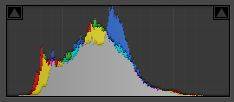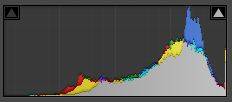You may have read my two posts about the value of exposing to the right in digital photography (also known as ETTR), What Lurks in the Shadows: The Case of the Black Cat and The Perfect Exposure, Or, When Things Don’t Look So Good. In the second one, I show you an example of where I nail my exposure — the photograph is exposed as brightly as possible without blowing out any significant highlights (any highlights at all, in this case):
 (For an explanation on how to read the histogram, see the first post.)
(For an explanation on how to read the histogram, see the first post.)
I often get the follow-up question from readers, “How do you expose it so perfectly, other than by bracketing and trial and error?”
It’s actually quite easy, once you get to know your camera. There are all kinds of exposure rules in photography — but when I switched to a digital camera, I have to admit that I abandoned most of them for the one I will explain below.
I should say first that I almost always shoot in manual exposure mode, because by the nature of what I like to photograph, I almost always have time to measure the exposure and set my aperture and shutter speed. If instead I am shooting a fast-moving or changing scene, I put the camera in aperture- or shutter-priority and take what my camera gives me. But these instructions are for when you have more time. They assume that you know how to shoot in manual exposure mode. You may need to look up in your camera manual how to accomplish these steps:
1. Set your camera to always display the histogram as it displays your photographed image. This way you will get instant feedback on how well you did on setting the exposure. I would also suggest that you turn the “blinkies” on — so that blown out highlights in your image flash on and off. This will immediately show you what is blown out.
2. Set your camera metering to spot metering, or, if not available, then partial. This will limit the exposure reading to the narrowest range of the center of your viewfinder frame. Understand from your camera manual what portion of the center your setting covers. For mine, spot metering covers the center circle.
3. Look at the scene you are going to photograph and identify the brightest part of it that you do not want to blow out. For me this is often the sky — unless the sky is completely washed-out gray, I generally don’t want the detail (color or clouds) to be blown out. However, if my subject is in the shadows, I know that I will have to let the sky go (or shoot multiple exposures and blend them with Photoshop or Photomatix, but that is not the direction of this post.) If not the sky, the brightest part that I don’t want to blow out is often a white or very bright subject, like a shirt.
3. Looking through your viewfinder, point the center of the frame at that chosen brightest part of your scene, zooming in if necessary so that it fills the inner circle.
4. Rather than “zeroing out the meter”, which would put this highlight at medium gray, set your shutter speed or aperture so that the meter reads shows just short of being blown out. It will take a little practice to figure out exactly where this is, but for my camera it is 1 2/3 stops brighter than zeroing out the meter. Once you figure out what the right answer is, it will always be the answer.
Looking through my viewfinder on my Canon camera, here’s what zeroing out the meter looks like:
And here I have increased the exposure by reducing the shutter speed or widening the aperture, so that the metered highlight is just short of blown out:
5. Shoot, and examine your histogram. If it isn’t as well-positioned as mine, why not? (Remember, what is important is the position, not the shape.)
If it looks like the histogram below,
then it is underexposed — for your camera, 1 2/3 stops (or whatever you tried) isn’t the right answer — experiment until you figure out what is.
If it looks like this:
then you have blown out highlights. Either you have (1) metered on something that is not as bright as the real brightest highlight in your scene, (2) not confined your metering to just that (instead, you may have included surrounding darker tones), or (3) not yet figured out what the “right answer” is for your camera — try a slightly lower exposure.
Keep in mind that if you are shooting in raw, that you actually have a little leeway — the histogram is showing some blown out highlights that you will find aren’t really blown out.
Finally, if your histogram looks like this:
then you have succesfully exposed to the right, as explained. However, in this case there is such a range of tones (i.e. such high contrast) in the image that the cost of not blowing out the highlights is blocking up and losing detail in the shadows. You need to make a choice in this case — is detail in the shadows more important than detail in the highlights, for this particular image? If so, increase the exposure and let the highlights go. Remember from What Lurks in the Shadows: The Case of the Black Cat, if what falls in the shadows needs to be brightened to look right, you will otherwise be revealing ugly noise and lack of detail.
Note that if you usually shoot in aperture or shutter priority with center-weighted or evaluative/matrix metering, don’t forget to switch your metering setting back, so that the meter reads more of your scene in these automatic modes.
Do you have a different technique? Share it with us by leaving a comment below.
[sc:signup]


